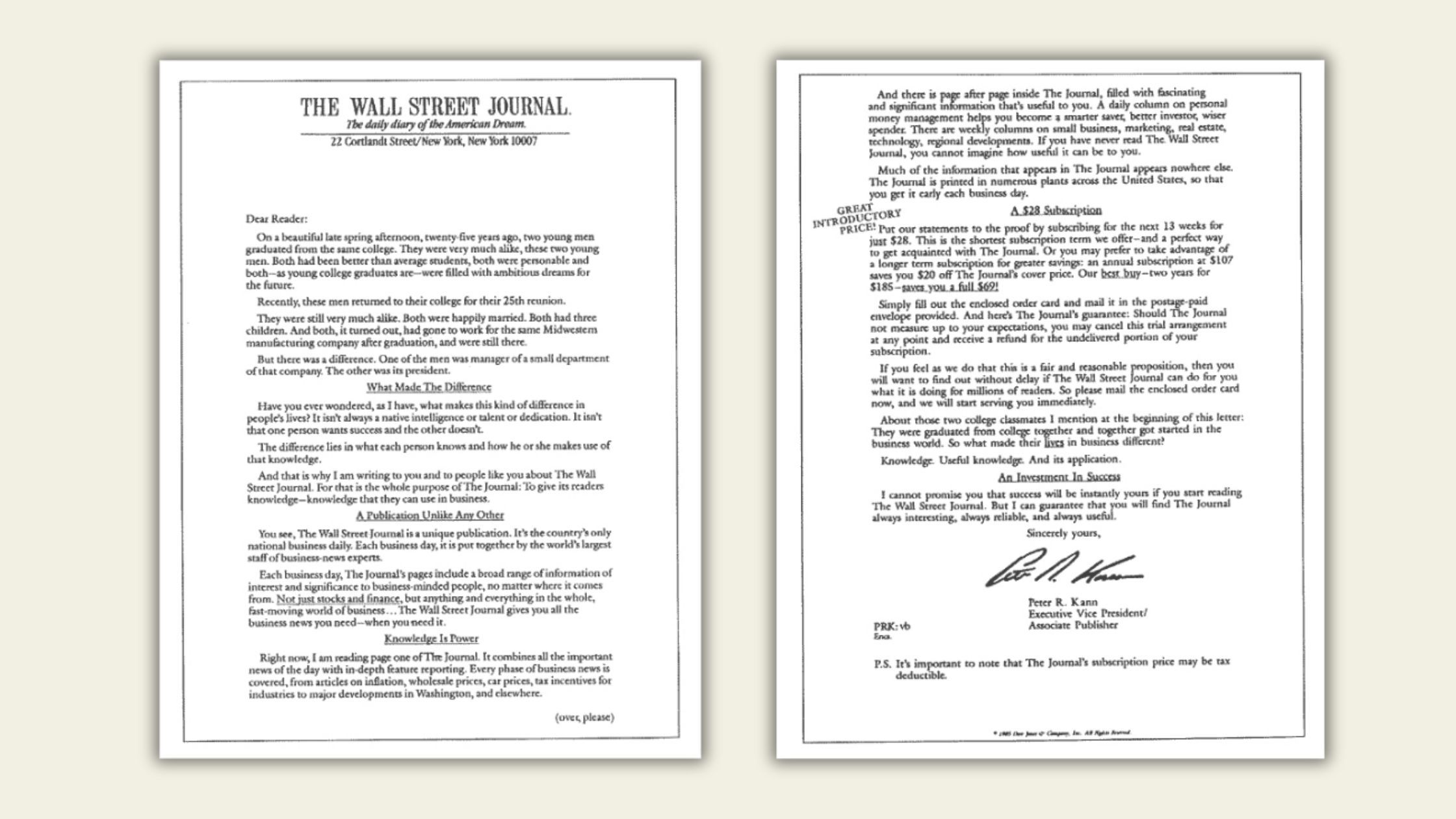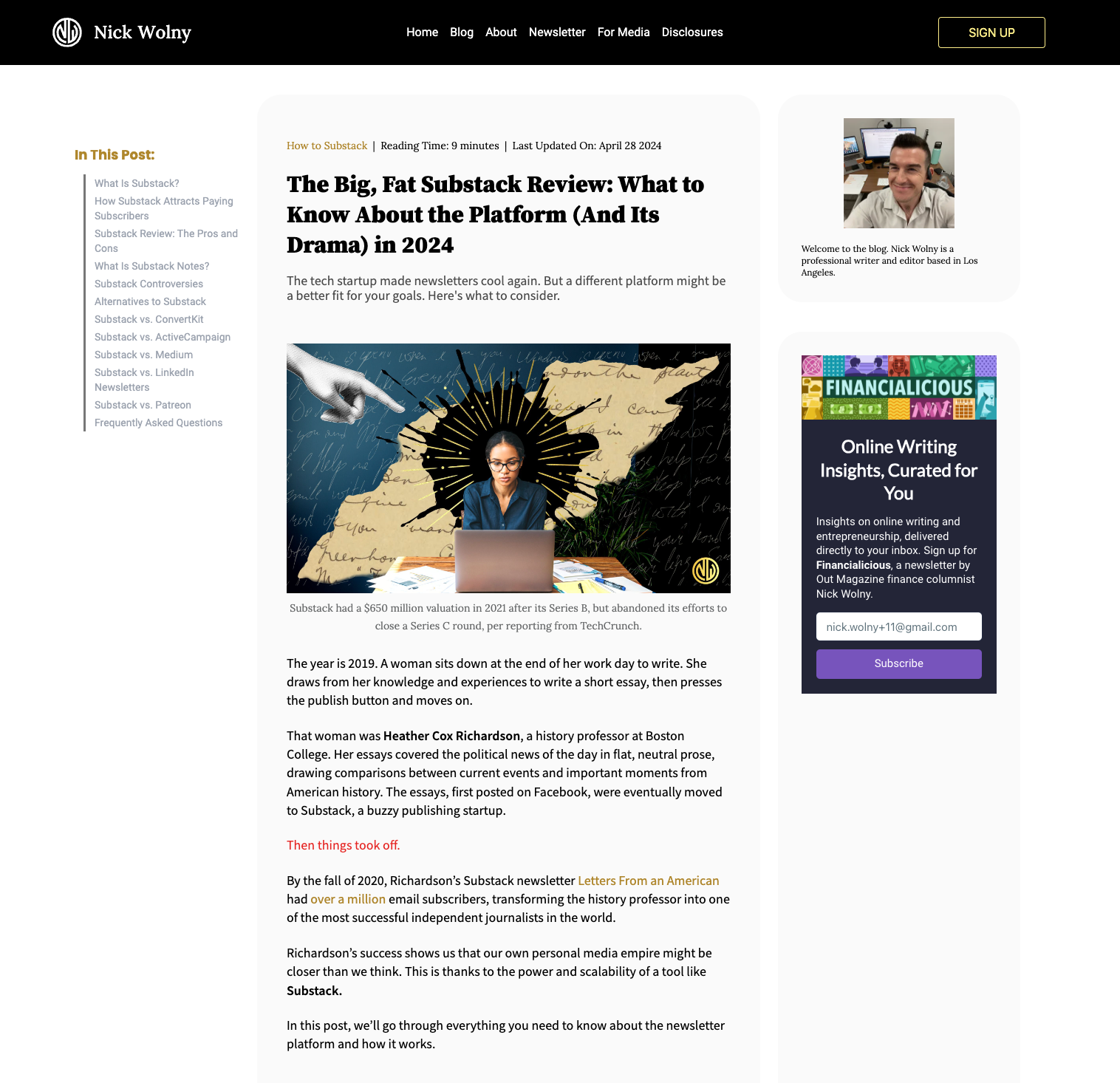One of the most successful advertisements in history was the “Two Men” letter by The Wall Street Journal. This sales letter is many copywriters’ Roman Empire; it produced over $2 billion in subscription sales for the paper over the course of the 21st century, largely without any edits or revisions.
Here is how the two men letter opens:
“On a beautiful late spring afternoon, twenty-five years ago, two young men graduated from the same college. They were very much alike, these two young men. Both had been better than average students, both were personable and both — as young college graduates are — were filled with ambitious dreams for the future.
Recently, these young men returned to their college for their 25th reunion. They were still very much alike. Both were happily married. Both had three children. And both, it turned out, had gone to work for the same Midwestern manufacturing company after graduation, and were still there.
But there was a difference. One of the men was manager of a small department. The other was its president.”
The letter then goes on to explain that the President, the desirable character in our story, had been a subscriber of The Wall Street Journal. The letter then touts the features and benefits of the Journal and offers an introductory price.

The two men letter in its entirety. Source via creative commons
The two men letter is an example of an anecdotal lead. By opening an article or post with an anecdote, you leverage storytelling elements that create a deeper psychological connection with your reader. Traditional leads usually don’t start with an anecdote, but when done well the anecdotal lead is one of the best ways to hook readers immediately.
If you want to tell stories like a seasoned features writer or magazine columnist, the anecdotal lead will help you get there. Anecdotes are stylish, and in today’s world the ability to share them can help you build influence and respect in your industry.
Key Takeaways
- An anecdote is a short story.
- Using one can illustrate an important point in an interesting or humorous way, giving you a way to land main points in a deeper way.
- Moreover, anecdotes let you inject personality into your writing, something that will become increasingly important in a world powered by AI.
Table of Contents
What Is a Lead?
In marketing, a lead refers to a potential customer. But in news writing, the word “lead” refers to the opening of a story. The lead summarizes the most important information to give readers immediate context.
- Breaking news stories will typically use a traditional lead or summary lead, which communicates the hard facts and little else.
- SEO writers might employ a question lead, opening their story with a question to pique a reader’s curiosity and establish relevance.
- In longer pieces, writers often use a descriptive lead to immerse us deeply into their worlds.
Headlines get all the love in marketing, and yes, they’re really important. But once we’ve gotten users onto the page, we need to keep them on the page. A good lead accomplishes this and gives your reader the scooch they need to get into your story and actually read the whole article.
Lead writing applies more to journalism, but learning how to write a lead can be a valuable skill for marketers. You’ll get better at being succinct and communicating the core of your message clearly.
And, Uh, What's an Anecdote Again?
An anecdote is a short story.
Stories can illustrate an important point in a compelling way, giving you an opportunity to land main points more deeply. This is because stories activate more parts of the brain, not just the part responsible for language processing. One study found reading a story activates 5x more brain power than facts alone.
Anecdotes will also become more valuable in the age of AI. Anyone can now ask AI to produce a blog or social media caption and get a result back in seconds. But AI can’t do stories the way humans can. Anecdotes let you inject personality into your writing, particularly when drawn from personal experience.
Types of Anecdotal Leads
Personal Stories
Personal experiences have a way of resonating with readers on a deep level. By sharing relatable anecdotes about yourself or others, you can draw your audience into your content, fostering a sense of connection.
For example, when writing about the importance of exercise, you could start with a story about yourself or a friend who transformed their life through fitness. This anecdotal lead immediately captures attention and sets the tone for your article.
Emotional Examples
Another effective way to engage readers is by evoking their emotions right from the beginning. Suppose you are writing an article on the impact of climate change. You could start with a powerful anecdote about someone who experienced the devastation of severe weather events firsthand.
By connecting your readers to the emotions of your story, they will be compelled to continue reading, eager to learn more about the subject at hand.
In this blog post on Substack, I use the origin story of one of the platform’s most successful writers, Heather Cox Richardson, to illustrate the power of the platform.

Industry Experiences
When promoting thought leadership, it can be helpful to use an anecdote to help illustrate a point.
For instance, if you are crafting an article about the importance of education, you could begin with an anecdote about an individual who overcame numerous obstacles to pursue knowledge. By presenting a relatable situation that highlights the significance of education, you inspire your readers to consider their own aspirations and the role education plays in their lives.
Anecdotal Lead Examples
An anecdotal lead is still a lead. Try to keep it short and to the point.
In this feature I wrote for CNET last year, my anecdotal lead for a 3,200-word story was five paragraphs, a total of ten sentences.
As soon as Josué Henriquez turned 18, he applied for a credit card. He wanted to start building his credit so he could one day finance the purchase of a car or home.
“I was told it was the only way I could start my credit in this country,” he says, having relocated to the US from El Salvador as a child.
His credit card limit was low at just $500, with a requirement to keep $250 in a savings account to use it. But over the next decade, as more offers rolled in, both his credit limits and balances ratcheted up. Henriquez’s credit card debt ballooned to over $25,000, and he eventually sought out a debt relief company for help.
“I had five credit cards at the time. Now I only have two,” he tells me. The rest were shut down in the relief process. Now 33, the San Francisco resident needed nearly four years to get his credit card debt down to zero.
Many of us are headed in the opposite direction.
By definition, an anecdote is a short story about a person, place, thing, or event. Anecdotes can be real or made up, but one of the most important features of an anecdote is reader appeal.
Here's an example of an anecdotal lead from tech publisher The Verge. The article was about the history of the TSA in the United States.
“People cry at airports all the time. So when Jai Cooper heard sobbing from the back of the security line, it didn’t really faze her. As an officer of the Transportation Security Administration (TSA), she had gotten used to the strange behavior of passengers. Her job was to check people’s travel documents, not their emotional well-being. But this particular group of tearful passengers presented her with a problem.”
Anecdotal leads can be happy, sad, angry, humorous, or a number of other emotions. Here’s a fun piece from satire website McSweeney’s showing examples of anecdotal leads for news stories if they were reporting the apocalypse.
As long as your short story gets the reader interested in the rest of your article, consider your mission accomplished.
Other Types of Leads (and How to Make Them Anecdotal)
You can always change an opening hook to an anecdotal lead later. Let’s look at examples of other types of leads and how this same information could have been presented through an anecdote instead.
Straight News Lead
A straight news lead answers a reader’s immediate questions about a news event. A rule of thumb is to start with the 5 W’s and 1 H: who, what, where, when, why and how. “So what?” and “Now what?” are also common questions that a lead might answer.
If a straight news lead can incorporate all of this information succinctly, that’s nice. But usually, answers to just two or three of the questions listed above are enough to get the point across.
- Example: The snowstorm led to school being canceled on Wednesday.
- Rewritten as an anecdotal lead: Abigail Jones doesn’t usually get to have a snowball fight on a Wednesday morning. But mother nature had a change of plans.
Summary Lead
The phrase “summary lead” is sometimes used interchangeably with news lead. But your article may not always be about news. A summary lead aspires to encapsulate an article in just a few sentences so that readers know what to expect.
- Example: This article will show you how to plant an herb garden in your backyard.
- Rewritten as an anecdotal lead: Spaghetti and meatballs night has never been more popular in the DeBose household. That’s because Grandpa Joe began growing the herbs for his legendary pasta sauce in the backyard last year.
Descriptive Lead
A descriptive lead is more common in feature writing, narrative writing and fiction writing. Rather than kicking off with reported details, a descriptive lead gives readers a deeper impression of the story by offering vivid descriptions of characters or scenery.
- Example: Galesburg, Illinois is surrounded by cornfields.
- Rewritten as an anecdotal lead: As soon as you leave my hometown of Galesburg, Illinois, you’ll be surrounded by cornfields as far as the eye can see. If you visit in the summer, the stalks are so tall they look like ocean waves crashing onto the shore, fluid and peaceful and full of life.
Still with me? Once you get the hang of an anecdotal lead, it’s a fun exercise that can spice up your writing.
Ways to Use Anecdotes in Marketing
You’re already interacting with anecdotes day in and day out. Here are the most immediate applications of anecdotal leads in marketing.
Client Stories and Testimonials
A testimonial is literally an anecdotal lead. “Since we bought the air fryer, my cholesterol is down 20 points without having to cut out the family recipes we love.” This is marketing gold for the air fryer manufacturer, because the message doesn’t lead with their product or how much it costs; it leads with the transformation that has occurred. Bonus points if you can get people on camera saying this stuff.
See if you can spot an testimonial anecdotal lead in the wild. If someone’s marketing is opening with a story, that’s an anecdotal lead.
Industry Context
Instead of yelling at users about how why you’re the solution, why not show the status quo in detail to better illustrate the problem?
From return-to-office (RTO) debates to spiking software costs, there’s probably a lot to comment on in your industry. An anecdotal lead can help readers marinate in the problem and realize how uncomfortable the problem really is.
Then, when you offer up your product, program or service as the solution, users will be more primed to listen. There’s no point to marketing if people aren’t listening.
Frequently Asked Questions
How Do You Write an Anecdotal Lead?
Start with a brief, engaging anecdote or story that introduces key themes or illustrates an important point related to the overall topic.
When Should You Use an Anecdotal Lead?
Use an anecdotal lead when you want a creative, engaging opening that quickly interests readers instead of just stating facts upfront.
Should Anecdotal Leads be Fiction or Nonfiction?
Anecdotal leads can incorporate fictional stories but should relate to real concepts. Nonfiction examples from personal experience often resonate most with readers."
Where Should You Place an Anecdotal Lead in an Article?
An anecdotal lead typically appears right at the beginning of a piece as the opening sentence(s) to immediately capture the reader's interest.
Can You Combine an Anecdotal Lead with Other Lead Types?
Yes. You can follow an anecdotal lead with a summary lead or nut graph paragraph for a creative opening paired with key context."
How Can Anecdotal Leads Showcase Expertise?
By sharing insider experiences and perspectives from within your field or industry, anecdotal leads can establish your credibility.
When Should You Avoid Using Anecdotal Leads?
Avoid anecdotal leads for pieces conveying major breaking news or sensitive topics requiring tact. Stick to direct facts in those cases.
The Takeaway
I love anecdotal leads. After eight years of professional copywriting, it feels good to do something a bit more heightened and editorial. Stories will also become increasingly valuable as AI-produced content floods our feeds with mediocre, impersonal posts.
Invest some time and effort into your storytelling skills and you’ll become a stronger, better marketer along the way. ◆
Thanks For Reading 🙏🏼
Keep up the momentum with one or more of these next steps:
💬 Leave a comment below. Let me know a takeaway or thought you had from this post.
📣 Share this post with your network or a friend. Sharing helps spread the word, and posts are formatted to be both easy to read and easy to curate, with nice image previews. You'll look savvy and informed.
📲 Connect on another platform. I’m currently publishing in these places. If you are too, say hello:
- Medium: Articles and thought essays.
- Threads: Casual, Twitter-esque commentary.
- Instagram: Media appearances, and some occasional IRL posts to Stories.
- TikTok: Occasional video scraps from reporting and life.
- LinkedIn: Buttoned-up posts.
📬 Sign up for my free email list. Financialicious is a free newsletter about online business and finance from a gay male editor’s perspective. Learn more and browse past editions here.
🏕 Up your writing game. Camp Wordsmith® is a content marketing strategy program for small business owners, service providers, and online professionals. Learn more here.
📊 Hire me for consulting. I provide 1-on-1 consultations through my company, Hefty Media Group. We're a certified diversity supplier with the National Gay & Lesbian Chamber of Commerce. Learn more here.


